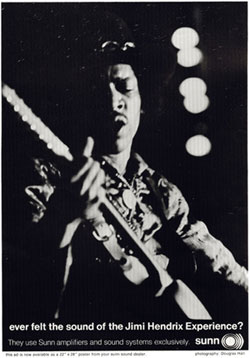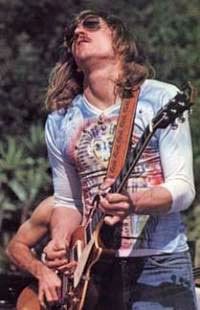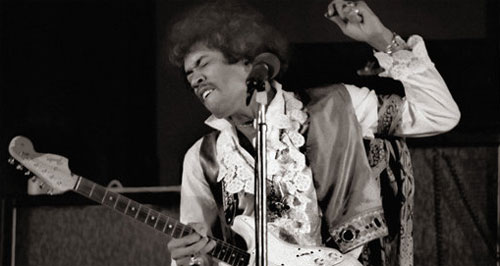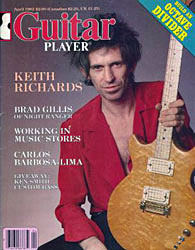3 Old Interviews: Hendrix, Walsh, Richards
I’ve had these three old Guitar Player magazine interviews kicking around on my desktop for a while now, decided to wind them up into one post. Interesting stuff, here are the most interesting tone-related excerpts:
Jimi Hendrix, December 1968
[This was before the usual Q&A format.]
A left-hander, [Hendrix] usually plays a right-handed Fender Stratocaster that’s flopped upside down and restrung the normal way with Fender light-gauge strings [9s]. He also has two Gibsons.
 “Some of the tracks on our new LP [Electric Ladyland] have a Gibson on them,†he says. “I also use Sunn amps. It doesn’t make any difference what size the amps are, as long as I know I have it. I’m not necessarily trying to be loud. I’m just trying to get this impact. I don’t like to use mics. To get the right sound, it’s a combination of both amp and fretting.
“Some of the tracks on our new LP [Electric Ladyland] have a Gibson on them,†he says. “I also use Sunn amps. It doesn’t make any difference what size the amps are, as long as I know I have it. I’m not necessarily trying to be loud. I’m just trying to get this impact. I don’t like to use mics. To get the right sound, it’s a combination of both amp and fretting.
“When I don’t say ‘thank you,’ or I turn my back to the audience, it’s not against them,†he explains. “I’m just doing that to get a certain thing out. I might be uptight about the guitar being out of tune or something. Things have to go through me, and I have to show my feelings as soon as they’re there.â€
One problem Jimi has is that his instruments won’t hold up. He explains: “Like these two guitars I have now, they’ve been around for a while and just don’t stay in tune. They might slip out of tune a bit right in the middle of the song, and I’ll have to start fighting to get it back in tune. We tune up between every song because it’s not a Flash Gordon show—everything all neat and rehearsed. It’s not one of those kinds of things. It’s important for us to get our music across the best way we can. It means we have to do it naturally, like tuning up before songs.â€
> On playing guitar: “You have to stick with it. Sometimes, you are going to be so frustrated you want to give up the guitar—you’ll hate the guitar. But all of this is just a part of learning because if you stick with it, you’re going to be rewarded.â€
> On originality: “When I see a group, I look for feeling, but not the jump-around kind of feeling,†he says. “Then I look for togetherness—a communication between the musicians. Originality comes about fourth or fifth.â€
Never saw/heard this one before.
Joe Walsh, October 1972
 GP: What guitars are you presently using? Have they been modified at all?
GP: What guitars are you presently using? Have they been modified at all?
Joe: I can’t live with anything but a Les Paul, because it gives maximum sustain to make a full sound. I took the chrome pickup covers off. I always use metal bridge parts, and screw the chrome butt just below the bridge all the way down to the body. It all helps sustain.
At home, I use an old Fender Telecaster—pretty much standard except that I rewired it to select upper, lower, or both pickups. I also had to take out the capacitor connected to the upper pickup, as it ruins any chance of a good sound from the upper pickup.
For me, Telecasters play best when the strings are low. They buzz just a bit and it adds to the funk. “Funk #49” was recorded entirely with a Telecaster and Vibroplex.
I also use a Gretsch Country Gentleman for recording. Try to find one with real f-holes, because the ones with painted f-holes are not as good. I love the Bigsby tailpiece on a Gretsch. “Midnight Man” was a good example of Gretsch sounds.
Wood!
Keith Richards, April 1983
GP: In the last few years there’s been a new aspect of your tone—more distinct, with a slight click, almost like a slap bass in rockabilly. “Hang Fire†and “She’s So Cold†are examples, and especially the last section of “Little T&A.â€
Keith: It’s our equivalent of that rockabilly thing. I think you’ll find that comes from using a lot of analog delay on Ron’s guitar or my guitar or both of them, and I dampen it. That’ll give you that ticka-tacka-ticka. I always use that green MXR analog delay. I’m told it’s quite out of date now and old fashioned, but I got it free and I forgot that time marches on and they make better ones, or so they say. I don’t know. I’ve worked very well with those MXR things, and they’ve been very reliable.
Can you judge the sound of an electric guitar before you plug it in?
Maybe to a certain extent. If the neck and the action feel right, you’re more than halfway home, even before hearing the electronics. Things like weight and the density of the wood indicate certain things, but you simply need to play it to really tell. And it doesn’t take long.
On record you’ve used several very different types of guitars—Gibson Les Pauls and ES-335s, Fender Telecasters, and others. And yet a listener can tell right away that it’s you, from stylistic clues, but also from the sound alone.
I use a whole load of different guitars, that’s true, but they’re not all that dissimilar in type. I mean, 90 percent are probably Telecasters, old ones, but more than that, you can’t really separate style and sound, you see. People do separate them when they’re talking about music, but all of that often misses the whole point.
You’re suggesting that the style is the sound?
Yes, part of it, more than any particular tone setting or pickup or anything like that. I’ll just adjust to the sound of the track as we go—the sound of the bass drum and especially Ronnie’s guitar. The style is adjusting along with the sound. There’s never a conscious effort to get that “Honky Tonk Woman†tone or a thing like that. You may get it or you may not. But that’s not what you’re thinking about. You’re thinking about the track.
Some people were amazed to read in your first Guitar Player cover story that on “Street Fighting Man†there are no electric guitars.
Two acoustics, one of them put through the first Philips cassette player they made. It was overloaded, recorded on that, and then hooked up through a little extension speaker, and then onto the studio tape through a microphone.
Not 1983, but cool!
Category: Fender, Gretsch, Jimi Hendrix, Joe Walsh, Keith Richards, Les Paul, MXR, Strat, Telecaster
















Wow, that Joe Walsh vid is killing me. Sure he buggers up the lyrics and song structure in a major way but the tone and intensity are blowing my mind. That Lester sure has seen some musical history especially if it’s the one that he gave to Page.
Thanks for posting that. It really opened my eyes to Joe’s live capabilities. I eventually found the Eagles version of Turn to Stone on uTube but it didn’t work for me. Too pretty when compared to this. Powerful stuff. I wish I knew what he was using amp-wise. I see lots of discussion about the gear he was using around that time, either a Twin or Marshall or Hiwatt (doesn’t sound Fendery to me though). Does anybody know?